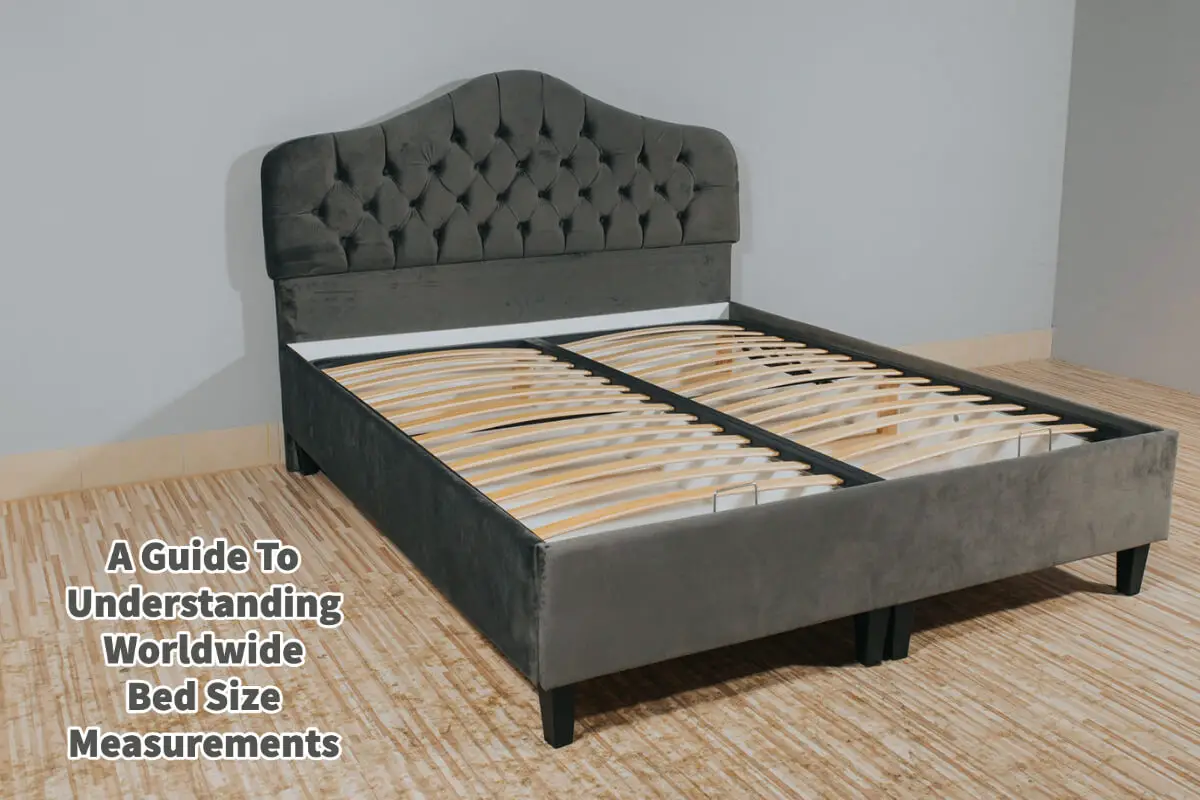Choosing the correct size is one of the most crucial considerations when purchasing a new mattress. However, the task becomes more complex when considering the variations in bedside measurements worldwide.
Worldwide, bed and mattress sizes are not standardized. Different regions of the world will have different mattresses and bed sizes. There can be different cultural reasons why this is the case, but if you are buying a bed or mattress from overseas, it may not fit precisely with the mattress you can get in your home country. Read on to explore these sizes and go deeper into why they can be different.
Table of Contents
- Standard Worldwide Bed Sizes Explored
- Why Bed Sizes Around The World Are Not The Same?
- Related Content
Standard Worldwide Bed Sizes Explored
Modern manufacturing conventions have led to standard bedding sizes, which differ across countries. We will delve into the diverse bedside measurements across regions, including North America, Australia, the UK, Ireland, Europe, Latin America, and more.
By understanding these variations, you will be better equipped to choose the perfect mattress.
North American Bedside Measurements
In North America, the standard bedside measurements for mattresses are as follows:
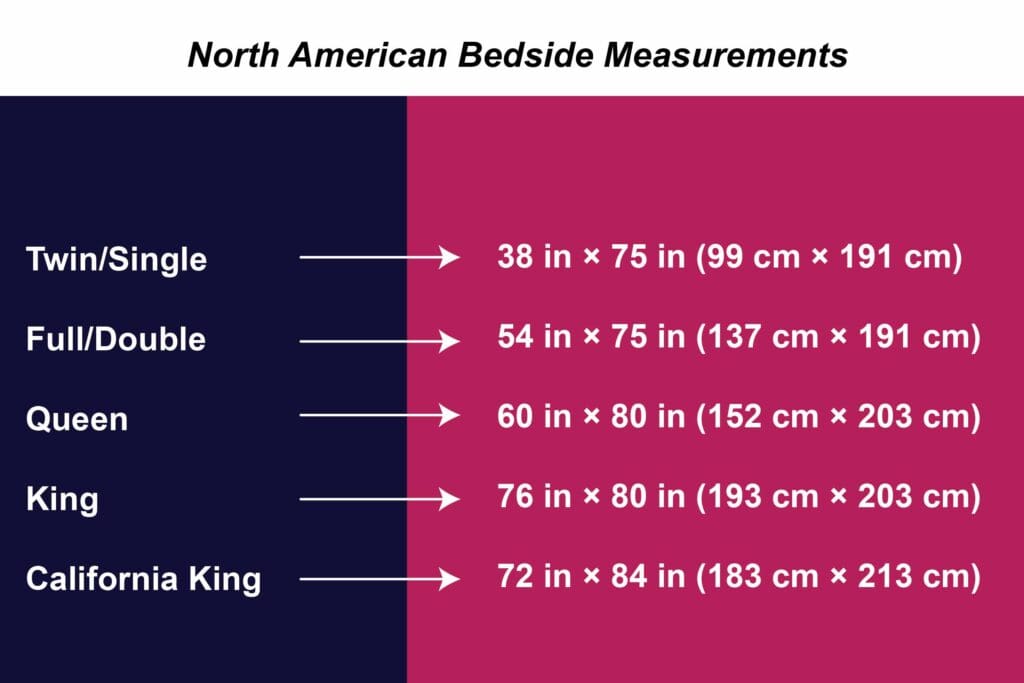
- Twin/Single: 38 in × 75 in (99 cm × 191 cm)
- Full/Double: 54 in × 75 in (137 cm × 191 cm)
- Queen: 60 in × 80 in (152 cm × 203 cm)
- King: 76 in × 80 in (193 cm × 203 cm)
- California King: 72 in × 84 in (183 cm × 213 cm)
Bedside Measurements In The UK And Ireland
The UK and Ireland have standard bedside measurements, generally smaller than the US. The dimensions are as follows:
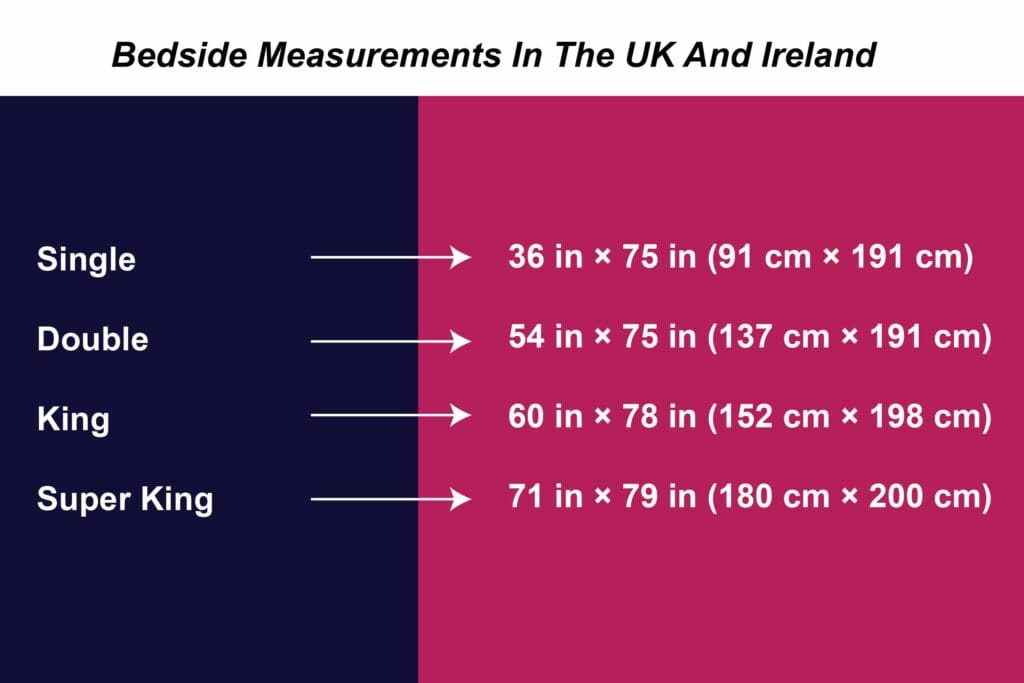
- Single: 36 in × 75 in (91 cm × 191 cm)
- Double: 54 in × 75 in (137 cm × 191 cm)
- King: 60 in × 78 in (152 cm × 198 cm)
- Super King: 71 in × 79 in (180 cm × 200 cm)
Bedside Measurements In Europe And Latin America
Continental Europe and Latin America follow similar sizing conventions to the UK but with a fixed length of 200 centimeters. The bed widths are given in centimeters rather than using terms like queen, king, or super king. Some common European bedside measurements include:
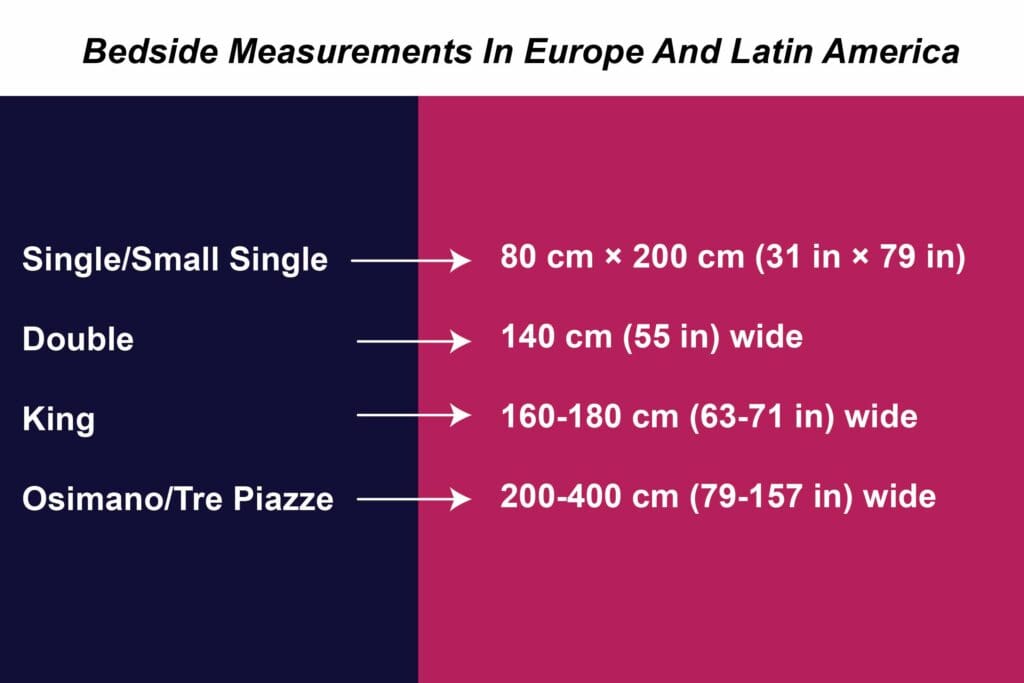
- Single/Small Single: 80 cm × 200 cm (31 in × 79 in)
- Double: 140 cm (55 in) wide
- King: 160-180 cm (63-71 in) wide
- Osimano/Tre Piazze: 200-400 cm (79-157 in) wide
Bedside Measurements In Australia And New Zealand
Australia and New Zealand have their unique sizing conventions for mattresses. The measurements are as follows:
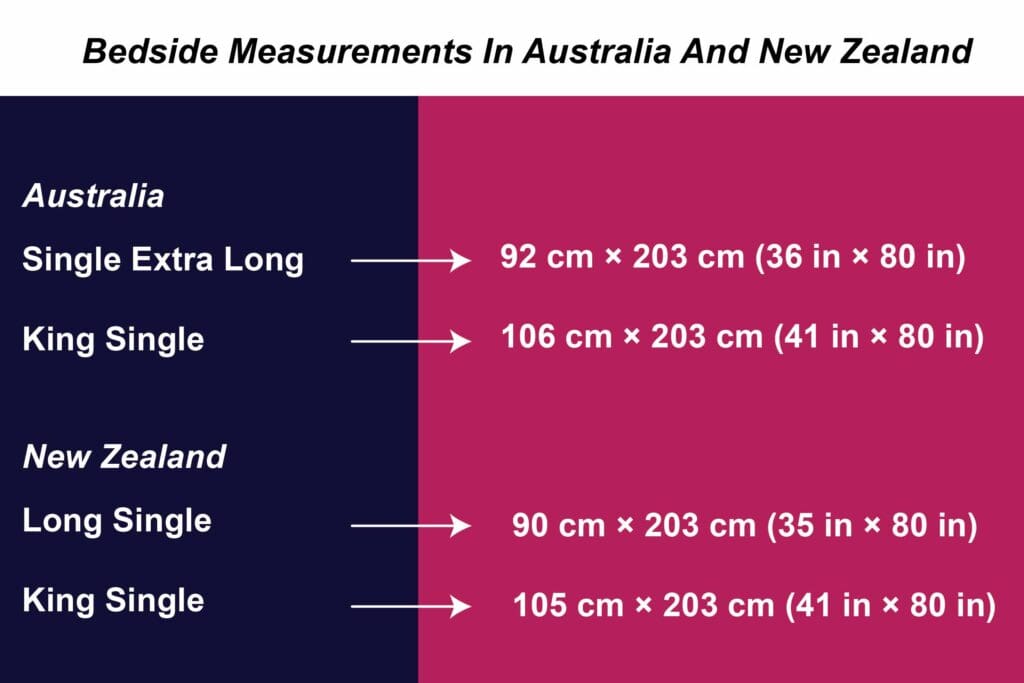
- Australia:
- Single Extra Long: 92 cm × 203 cm (36 in × 80 in)
- King Single: 106 cm × 203 cm (41 in × 80 in)
- New Zealand:
- Long Single: 90 cm × 203 cm (35 in × 80 in)
- King Single: 105 cm × 203 cm (41 in × 80 in)
Scandinavian Bedside Measurements
Scandinavian countries have variations in mattress sizes. Here are some standard measurements in Norway:
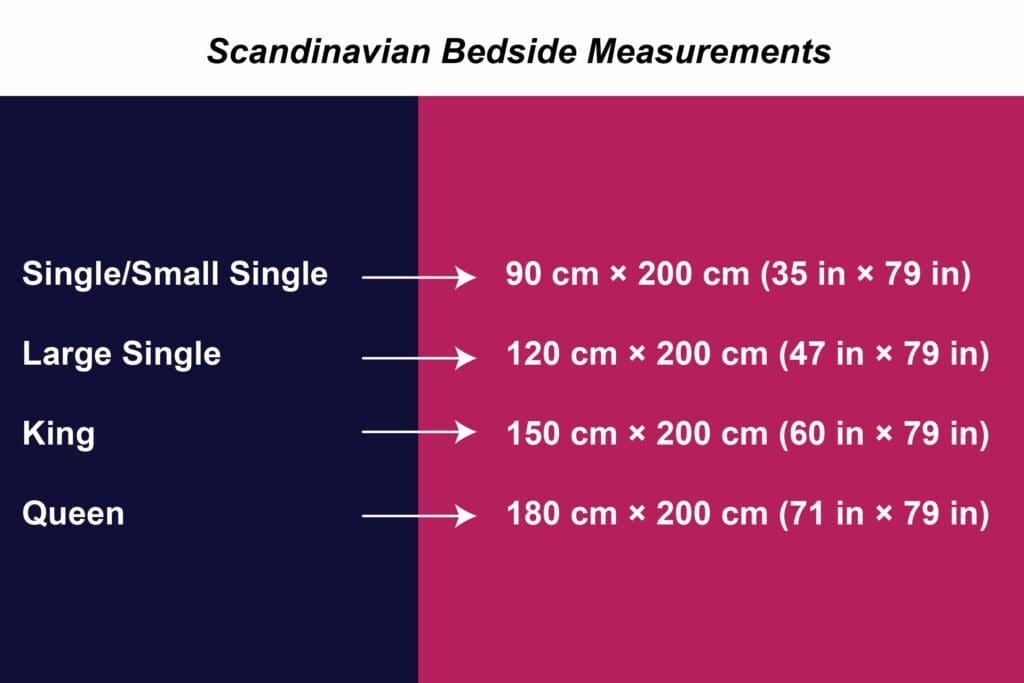
- Single/Small Single: 90 cm × 200 cm (35 in × 79 in)
- Large Single: 120 cm × 200 cm (47 in × 79 in)
- King: 150 cm × 200 cm (60 in × 79 in)
- Queen: 180 cm × 200 cm (71 in × 79 in)
Other Bed Sizes Explored
Even though these are the primary bed sizes around the world. There is still another size you may need to consider. Here are some other considerations:
Other Notable Bed Sizes
There are several unique bed sizes found in specific regions. For example, the Emperor bed size in the UK measures 84 in × 84 in (213 cm × 213 cm), providing an incredibly spacious sleeping area.
In Italy, beds are classified by width, with sizes like Una Piazza, Piazza Francese, and Tre Piazze/Osimano, offering a range of options to suit different preferences.
Historical And Antique Bed Sizes
It’s interesting to note that bed sizes have evolved. Older beds often had shorter lengths, reflecting people’s sleeping habits and average heights in past eras.
Antique beds may have unique measurements and designs, often differing significantly from modern standardized sizes.
Why Bed Sizes Around The World Are Not The Same?
When they visit another country, many people may not fully understand that bed sizes can differ from country to country. Bed sizes worldwide vary due to historical, cultural, and practical reasons.
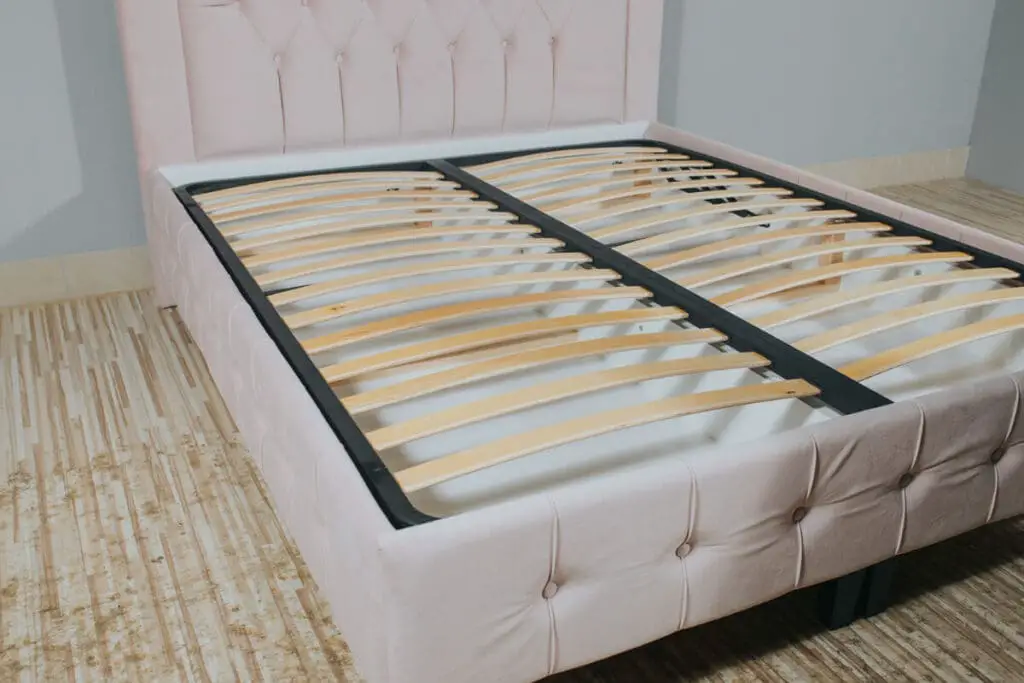
Here are some factors that contribute to the differences in bed sizes:
Cultural Differences
Cultural norms and preferences often influence bed sizes. Different cultures have different sleeping habits, family structures, and living spaces, which can influence the size and design of beds. For example, in some countries, co-sleeping with family members is expected, so more extensive beds are preferred to accommodate multiple people.
Historical Development
Bed sizes have evolved, reflecting historical trends and societal changes. Standard bed sizes were often based on practical considerations and available materials. As societies developed, standardization efforts emerged, but these varied across regions and countries, establishing different bed sizes as norms.
Living Space And Bedroom Design
The sizes of bedrooms and living spaces also influence bed size variations. Smaller beds may be more common in densely populated areas with limited space.
In contrast, larger beds may be prevalent in countries with larger homes or a cultural preference for spacious bedrooms.
Manufacturing And Industry Practices
The bed manufacturing industry also plays a role in bed size standardization. Different countries and regions have their bed manufacturing practices, which can influence the available sizes of beds.
In some cases, the availability of standardized bed sizes may be influenced by the dominant manufacturers and retailers in a particular market.
International Influences
Globalization and international travel have led to the adoption and diffusion of various bed sizes. Influences from other countries’ bed sizes and international standards may have shaped the choices and preferences of consumers in different regions.
It’s important to note that while there are standard bed sizes within specific regions, there is still considerable variation, even within those regions.
Bed sizes can also differ between countries that share cultural or geographic proximity. Therefore, the specific reasons behind bed size variations can be complex and multifaceted.
If you are interested in seeing how Mondoro can help you with your home furniture or home decor products – we would love to talk to you about how we can help you.
Find out more about how Mondoro can help you create, develop, and manufacture excellent home decor and furniture products – don’t hesitate to contact me, Anita. Check out my email by clicking here or become a part of our community and join our newsletter by clicking here.
Mondoro gives out a FREE Lookbook to anyone interested. You can receive a copy of our latest Lookbook by clicking here.
Listen to our Podcast called Global Trade Gal. You can find it on all major podcast platforms. Try out listening to one of our podcasts by clicking here.
Subscribe to our Mondoro Company Limited YouTube Channel filled with great videos and information by clicking here.
Related Content
What Is The Largest Mattress Size? Mattress Sizes Explained
The largest oversize mattress that you can buy is called a family XL. It is a large enough mattress that a whole family should be able to sleep on. The bed is 144 inches x 84 inches. Suppose you want to buy an oversize mattress. In that case, you will usually need to buy the sheets, bedding, and mattress from specialty retailers who specialize in selling oversize mattresses, bedsheets, and other accessories.
By clicking here, you can learn more about reading our blog on What Is The Largest Mattress Size? Mattress Sizes Explained.
Foam Mattress Vs. Pocket Coil Mattress Differences Explained
If you were looking to purchase a foam mattress or a pocket coil mattress and were unsure which mattress would be better for you, there are some differences between a foam mattress and a pocket coil mattress. One of the main differences will be how you feel when you sleep on the bed and what type of support each mattress will give you.
By clicking here, you can learn more about reading our blog on Foam Mattress Vs. Pocket Coil Mattress Differences Explained.
Can You Bend A Coil Spring Mattress?
It would help if you did not bend a coil spring mattress. A coil spring mattress is made with a metal frame with interconnected springs on the bed. If you bend a coil spring mattress, you could damage the mattress. If you need a mattress that can compress or bend, we recommend getting a pocket coil mattress.
You can learn more by reading our blog, Can You Bend A Coil Spring Mattress? by clicking here.

